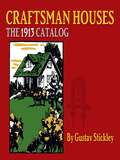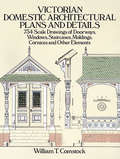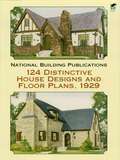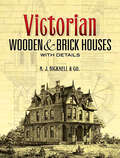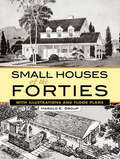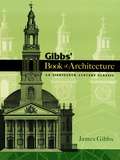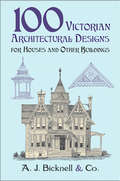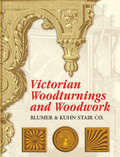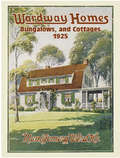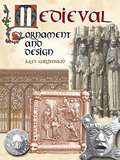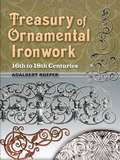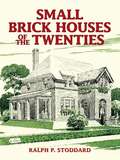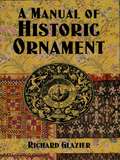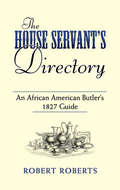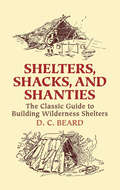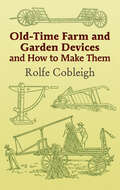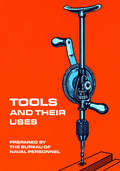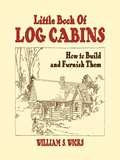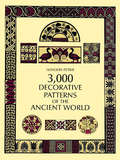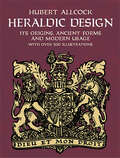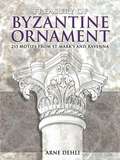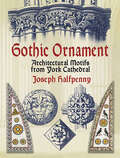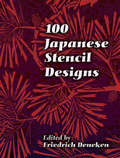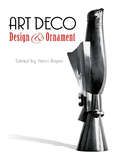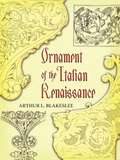- Table View
- List View
Craftsman Houses: The 1913 Catalog
by Gustav StickleyGustav Stickley pioneered a form of architecture based on beauty, simplicity, utility, and organic harmony. This inexpensive reprint of a very rare catalog testifies to the enduring charm of his designs. It comprises numerous architectural drawings and photographs of Mission-style homes, including floor plans and descriptive text."Planned for comfort, convenience, and economy," each of these homes features a simple arrangement of rooms and sturdy structural features. Combining good taste with practicality, they offer openness for common household life, as well as sufficient seclusion for privacy. Models range from a two-family house of cement or stucco to a nine-room cottage of brick and shingles and a seven-room country bungalow. Restorers of old houses, preservationists, and students of American architectural history will prize this well-illustrated treasury of authentic plans and details.
Victorian Domestic Architectural Plans and Details: 734 Scale Drawings of Doorways, Windows, Staircases, Moldings, Cornices, and Other Elements (Dover Architecture)
by William T. ComstockVictorian architecture, with its quirky diversity, eclectic origins, and exuberant ornamentation, continues to exert a strong attraction on today's architects, builders, and homeowners. For those interested in restoring, preserving, or even re-creating Victorian homes, authentic plans and designs are invaluable. This volume, meticulously reproduced from a rare nineteenth-century publication, offers an exceptionally rich pictorial record of actual mid- to late-Victorian designs.Extremely clear and detailed engravings — drawn to scale — present elevations, floor plans, perspectives, and other drawings (in some cases, complete framing plans) for country houses and cottages in a variety of styles: Queen Anne, Eastlake, Elizabethan, Colonial, Jacobean, Southern, Californian, and more. There are even designs for several store and office fronts, with counters, shelving, etc.Supplementing the large number of complete designs are nearly 700 large-scale drawings of virtually every architectural detail, many embodying the unique "gingerbread" that characterizes Victorian buildings. Included are clear, precise renderings of balusters, brackets, dormers, fireplaces, finials, gables, mantels, moldings, newels, porches, rafters, rosettes, staircases, transoms, verandahs, wainscoting, windows, and hundreds of other features.Restorers of old houses, preservationists, students of American architectural history, admirers of Victoriana, and anyone interested in the Victorian Gothic styles that dominated American domestic architecture in the late 1800s will want to have this inexpensive treasury of authentic century-old plans and details.
124 Distinctive House Designs and Floor Plans, 1929
by National Building PublicationsAn annual publication intended as a reference work for contractors, suppliers, architects, and homeowners, the 1929 Home Builders Catalog offered a beautifully illustrated look at a variety of homes. Painstakingly reproduced from a rare edition, this volume offers old-house restorers, preservationists, and lovers of 1920s architecture an authentic view of American homes of the era.
Victorian Wooden and Brick Houses with Details
by A. J. Bicknell Co.This vintage volume offers a treasure trove of floor plans, elevations, and details of residences and public buildings. Artists, architects, and historians alike will find it an endless source of inspiration.Featured buildings include villas, cottages, and farm houses as well as churches, schools, banks, and many other structures. Eighty-one remarkably detailed illustrations capture the elaborate, distinctive beauty of Victorian-era cornices, staircases, gables, verandas, doors, dormers, and other architectural elements. In addition, a fascinating "Specifications" section highlights construction guidelines for masons, bricklayers, and carpenters.
Small Houses of the Forties: With Illustrations and Floor Plans
by Harold E. GroupDesigned for the 1940s family with a "limited budget but unlimited good taste," this fascinating volume presents 56 floor plans and elevations of lovely small homes that originally cost less than $15,000 to build. Each home, bearing the honorable designation of House-of-the-Month by the era's Monthly Small House Club, Inc., was designed to give prospective homeowners an exceptionally well-planned house that was also a sound investment. From Cape Cods to Colonials, Small Houses of the Forties offers an eden of illustrations of cozy, charming domiciles, complete with color combinations, charts, and diagrams. This complete republication of a now-rare volume is also filled with vintage dollars-and-sense information for the postwar homebuyer, including mortgage guidance, amortization schedules, valuations, and construction costs of the times. <p><p> A nostalgic flashback to a simpler American dream of white picket fences, this entertaining and valuable reference will delight architecture enthusiasts, plan collectors, restorers, and historians alike.
Gibbs' Book of Architecture: An Eighteenth-Century Classic
by James GibbsOne of England's most respected and influential architects, James Gibbs was born in Scotland, studied in Rome, and left a legacy of design the world will treasure forever. His legendary 1728 folio, a sprawling gallery of Gibbs's magnificent drawings, perspectives, and blueprints, is a brilliant testimony to his remarkable talent. Profusely illustrated, the volume features such notable commissions as London's St. Martin in the Fields -- the inspiration for many steeple churches of the colonial period in America; St. Mary le Strand, his first public building; Marybone Chapel; The Church of Allhallows in Derby; plus Gibbs's first commission, an addition for King's College at Cambridge. His most outstanding accomplishment may be the circular Radcliffe Library at Oxford, for which he received a Master of Arts. Also included here are detailed floor plans, plus fine drawings of decorative marble cisterns, ornamental iron gates, stately funeral monuments, and much more. Essential for an understanding of classic architecture, this stunning edition should grace the bookshelf of every architect, as well as architectural students, teachers, and historians.
100 Victorian Architectural Designs for Houses and Other Buildings (Dover Architecture)
by A. J. Bicknell Co.Originally published in 1878, this now-rare collection of designs supplies views of a remarkable variety of modestly priced structures: houses, villas, cottages, many others. Handsome drawings of perspective views and elevations, some of which include floor plans, plus suggestions for interior design. 98 black-and-white illustrations.
Victorian Woodturnings and Woodwork (Dover Architecture)
by Blumer Kuhn Stair Co.Reproduced from a rare original, this 1893 catalog offers nearly 800 detailed and authentic illustrations of superior-quality woodturnings and woodwork. In addition to its conventional examples, it features varied and unusual models of the Victorian style, including stairs, stair railings and balusters, and newel posts; mantels; turned porch and veranda work; gables and window hoods; ventilators; rosettes and other wooden ornaments; and moldings and interior finish.An excellent guide for woodturners and cabinetmakers, this volume also provides an inspiring and instructive resource for architects, preservationists, designers, and students of Victoriana.
Wardway Homes, Bungalows, and Cottages, 1925 (Dover Architecture)
by Montgomery Ward Co.Meticulous reproduction of a rare catalog includes floor plans as well as exterior and interior views of 80 American homes, among them a handsome, three-story frame residence with six bedrooms and a cozy, three-room cottage measuring 18 feet by 22 feet. 94 black-and-white illustrations depict handsome stairways, French doors, and other amenities.
Medieval Ornament and Design
by Jules GailhabaudThis lavish archive of exquisite engravings and designs--originally created in the mid-nineteenth century for the professional artist and architect--contains some 200 splendid illustrations, expertly adapted from decorative as well as utilitarian features of medieval cathedrals, churches, tombs, houses, shops, public buildings, and other structures. Encompassing a wide variety of styles, the designs include finely detailed panels, gawking gargoyles, marvelously carved pillars and pedestals, exquisite ironwork patterns, decorative stonework, magnificent stained glass windows, moldings enhanced with intricately woven motifs, and much more.Artists, designers, and craftworkers will find wide use for these versatile, royalty-free illustrations. Students of architecture, art historians, and lovers of ornamental art will delight in the pure beauty of this magnificent collection.
Treasury of Ornamental Ironwork: 16th to 18th Centuries
by Adalbert RoeperSixty vintage black-and-white plates illustrate the history of German decorative ironwork from the16th to the 18th centuries. A hard-to-find celebration of the diversity and enduring beauty of Germany's handcrafted iron embellishments, this magnificent edition exhibits striking views of metal doors, balconies, window arches, gates, corner pieces, decorative accessories, and more, many wrought with gargoyles, human figures, and florals. A rich source of inspiration and an accurate, invaluable reference for art historians, architects, craftworkers, and designers.
Small Brick Houses of the Twenties
by Ralph P. StoddardOnce affordable only among the wealthy, brick homes became more easily available to the average American in the early years of the twentieth century. This book, originally published in 1920 by a member of The Common Brick Manufacturers' Association, served as a practical guide for prospective homeowners from working class families. Many soon found that attractive, durable, and comfortable homes--made from nature's own building material--were easily within their financial reach. <p><p> Thirty-five sets of floor plans, elevations, and specifications in this excellent reproduction of that now-rare volume depict a wide variety of brick houses, bungalows, cottages, garages, and multi-dwelling buildings--from the four-bedroom Pocatello to the handsome Saratoga, featuring a wraparound porch and two bathrooms. This practical guide will appeal to anyone wanting to buy or renovate an existing home of the period. It will also serve as a how-to manual for all desiring to build their own homes today with authentic materials and techniques. For those who love fine, old buildings, Small Brick Houses of the Twenties offers a charming view of American homes from that era.
A Manual of Historic Ornament
by Richard GlazierExceptionally comprehensive, easy-to-use guide surveys the evolution of historic ornament in architecture and the applied arts — from primitive ornaments of Oceania, Egypt, and Assyria to a Gothic doorway in Amiens, the tomb of Lorenzo de Medici, and a classic early-19th-century sofa by Thomas Hope. Over 700 black-and-white illustrations. 16 plates of photographs.
The House Servant's Directory: An African American Butler's 1827 Guide (American Antiquarian Cookbook Collection)
by Robert Roberts"In order to get through your work in proper time, you should make it your chief study to rise early in the morning; for an hour before the family rises is worth more to you than two after they are up."So begins Robert Roberts' The House Servant's Directory, first published in 1827 and the standard for household management for decades afterward. A classic survey of work, home life, and race relations in early America, the book was the result of many years of Roberts' personal and professional experiences. One of the first books written by an African-American and published by a commercial press, this manual for butlers and waiters offers keen insight into the social milieu, hierarchy, and maintenance of the antebellum manor.As a servant to a prominent New England family, Roberts provided valuable insights into what was expected of domestic servants. His book contains an abundance of instructions for successfully completing household chores as well as suggestions for properly cleaning furniture and clothing; and for buying, preparing, and serving food and drink for dinner parties of all sizes (much of which is still useful information today). The text also contains suggestions for arranging servants' work routines, and advice to heads of families on how best to manage their domestic help -- extraordinary recommendations for master-servant relationships and highly unusual for the time.Among the most famous of etiquette books to provide instruction on proper behavior for domestic servants in the early nineteenth century, Roberts' Directory remains a critical primary source in sociology and African-American history.
Shelters, Shacks, and Shanties: The Classic Guide to Building Wilderness Shelters
by D. C. BeardThis excellent hands-on guide by one of the founders of the Boy Scouts of America contains a wealth of practical instruction and advice on how to build everything from a bark teepee and a tree-top house to a log cabin and a sod house. No professional architects are needed here; and knowing how to use an axe is more important than possessing carpentry skills. More than 300 of the author's own illustrations and a clear, easy-to-follow text enable campers to create such lodgings as half-cave shelters, beaver mat huts, birch bark shacks, over-water camps, a Navajo hogan, and a pole house. <p><p> Additional chapters provide information on how to use an axe, split and notch logs, make a fireplace, and even build appropriate gateways to log houses, game preserves, ranches, and other open areas. An invaluable book for scouts, campers, hikers, and hunters of all ages, this guide and its fascinating collection of outdoor lore "still has intrinsic value," said Whole Earth Magazine, and will be of keen interest to any modern homesteader.
Old-Time Farm and Garden Devices and How to Make Them
by Rolfe CobleighA splendid bit of rural Americana, Cobleigh's book shows how anyone with a little time and money can add a touch of authentic charm to their farm, house, or garden. First published nearly a century ago, this practical guide features dozens of projects, accompanied by some 200 illustrations. A simply written text not only tells how to mount an anvil, make a cheese press, and build hog houses, but also provides handy advice on splitting wood, testing seed corn, tying practical knots, sharpening scissors, and papering a room.From building a rose trellis to creating a bicycle-powered washing machine, readers will delight in this book’s abundance of enjoyable and useful projects. It’s perfect for novice craftworkers and die-hard fans of Yankee ingenuity.
Tools and Their Uses
by U.S. Bureau of Naval PersonnelDo you have trouble with tools — find that they wear out too quickly, find that you can't decide which tools to buy or which tools to use for a specific job, find that little things continually go wrong? The only way to learn to use tools, of course, is by using them, but first you have to know which tools to use and why.This manual, originally prepared for the use of naval personnel, was designed to present the basic hand and power tools that the ordinary person is likely to use. Through a wealth of diagrams, clear explanations, safety tips, and operating instructions you will soon learn the basics of choosing tools and using them as they were meant to be used. Nearly every hand tool you are likely to use around the house is described in the first chapter: hammers, wrenches, screwdrivers, wood saws, planes, wood chisels, metal chisels, dies, drills, files, hacksaws, punches, reamers, taps, clamps, vises, pliers, knives. Chapter two covers the common power tools: drills, grinders, sanders. Chapter three covers measuring tools from rules and tapes to calipers, micrometers, and squares with detailed instructions on how to use each one. Chapter four describes the common nails, screws, bolts, nuts, rivets, and other fasteners you are likely to use. Chapter five describes grinders and shows how to sharpen and care for screwdrivers, chisels, drills, and snips. The final two chapters cover such miscellaneous tasks and tools as metal cutting operations, stripping insulated wire, and soldering techniques.By the time you finish you should know the names, general uses, and correct operation of all the basic tools, fasteners, and measuring devices you are likely to need around the house. You should be able to select tools for a basic kit for doing simple home repairs. And you should be confident in beginning to use tools for yourself to perform all those simple but necessary repair jobs.
Little Book of Log Cabins: How to Build and Furnish Them
by William S. WicksOver a century ago, when he first wrote this little guide, William Sydney Wicks (1854–1919) whimsically observed that while early man lived in nature out of necessity, modern man has taken to the woods by choice. Wicks was a highly successful architect whose imprint can still be seen throughout Buffalo, New York, in dozens of churches, hotels, libraries, houses, and other structures. For several years, he was also Buffalo's park commissioner. Wicks' lovely little how-to manual—complete with simple diagrams and step-by-step details—is the ideal dream book for people who think of someday building their own rustic cottage. It's a charming repository of practical shelters and make-it-yourself log furnishings that will inspire every home craftsman and everyone who yearns to get back to nature. Building instructions are accompanied by clear, accurate line drawings of simple log structures, lean-tos, fancy Adirondack cabins, fireplaces, stairways, furniture, beamed ceilings, and much more. A perfect guide for anyone who loves the outdoors, the Little Book of Log Cabins will provide a feast for browsing and for practical projects.
3,000 Decorative Patterns of the Ancient World (Dover Pictorial Archive)
by Flinders PetrieMythical animals, florals, rosettes, religious and secular symbols, more.
Heraldic Design: Its Origins, Ancient Forms and Modern Usage
by Hubert AllcockThrough the ages, as warfare and competitive rituals became more elaborate, heraldry evolved into an exact art and science. Used to denote accomplishments as well as the genealogies of outstanding individuals and families, these symbols survived the way of life that created them.This remarkably rich sourcebook of royalty-free designs describes the origins and ancient forms of heraldic devices, shields, and trademarks. Over 500 black-and-white drawings trace the history and meaning of the coat, shield, crests, helmets, blazonry, and "attitudes and attributes" of symbols, with considerable attention given to devices such as beasts, monsters, and human and part-human figures. American, British, French, Russian, and other coats of arms are displayed, as are insignias of the Pope and clergy, state seals, and emblems of many modern institutions. In addition to personal, commercial, and family arms, chapters also provide information on the use of heraldry in advertising, brand-labeling, and related fields.A valuable visual reference for anyone interested in genealogy, these handsome images will add a touch of class to a variety of art and craft projects.
Treasury of Byzantine Ornament: 255 Motifs from St. Mark's and Ravenna
by Arne DehliThe art of the Eastern Roman Empire and of its capital, Byzantium (Constantinople), found expression throughout the ancient world, particularly in Italian architecture. This superb archive of Byzantine ornament contains a wealth of decorative architectural elements derived from sixth- and seventh-century Italian buildings in Ravenna and in the Venetian church of St. Mark's.Depicted in more than 250 delicate line drawings are splendid perforated marble panels, intricately fashioned stone grilles and cornices, lavish candle brackets, elaborate stone mosaics for floors and ceilings, bronze window guards, as well as an abundance of decorative wreaths, rosettes, mouldings, and medallions.A multipurpose reference for students, artists, and designers, this archive of sumptuous, royalty-free designs will also serve as a rich source of inspiration for anyone working in the fine or applied arts.
Gothic Ornament: Architectural Motifs from York Cathedral
by Joseph HalfpennyThese royalty-free motifs feature exquisite specimens of the sculptured ornaments from northern Europe's largest medieval cathedral. The Cathedral and Metropolitical Church of St. Peter in York, popularly known as York Minster, was founded as a missionary church. Its soaring Gothic architecture and vast interior, parts of which date back to the 13th century, feature some of the best examples of the medieval craftsman's work to be found anywhere.This compilation consists of 175 illustrations, selected from throughout the cathedral. Like the building of the church itself, the ornaments were executed during different eras. This collection, reproduced from a rare 18th-century volume, offers artists and graphic designers an unusual selection of authentic architectural motifs from the Middle Ages.
100 Japanese Stencil Designs (Dover Pictorial Archive)
by Friedrich DenekenThe natural Japanese affinity for decorative art is apparent in this striking collection of exquisite stencil designs. A centuries-old tradition of capturing nature in striking floral and wildlife motifs is reflected in the graceful shapes and lovely lines of more than 100 illustrations. Lush blossoms, bamboo branches, butterflies, birds on the wing, and rustic country homes, among other subjects long associated with Japanese art, are boldly printed in black and white.Ready for use as patterns for wallpaper, textiles, graphics, and needlework, these delicate royalty-free images are ideal for a host of modern decorative and graphic needs.
Art Deco Design and Ornament
by Henri RapinA major design movement of the 1920s and 1930s, Art Deco drew its strength from architecture, modern art, primitivism, and industry. It gave us the Chrysler Building and Soviet post art -- and also gave us a legacy that continues to pulse with energy and excitement even today.In this rich collection of 349 images, the Art Deco style is evident in every draping vine, languid curve, bulging muscle, and geometric figure. It will leap out at you from friezes, plaques, sculpture, vases, doorways, tiles, furniture, arches, and more.It's a splendid book for anyone interested in the arts -- and for artists and craftsmen, a genuine wellspring of artistic ideas.
Ornament of the Italian Renaissance
by Arthur L. BlakesleeThis glorious gallery of stunning architectural accents from Italy's Middle Ages has been assembled from a rare, early-twentieth-century publication: * Grotesques from carved panels of choir stalls* Breathtaking tombstone and ceiling ornaments * Sumptuous stone balcony panels... and much more, all reproduced in sixty richly detailed illustrations. Designers and artists of every variety will revel in this modestly priced treasury of authentic Renaissance style.
